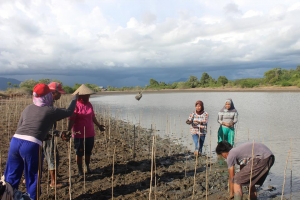Ten years after the Tsunami, mangrove forests planted as coastal shield
Article in New Scientist magazine tells the story of Aceh ten years later
Location: Aceh, Indonesia. 26th Dec 2014
New Scientist author Fred Pearce explores this question on his visit to Aceh, Indonesia in commemoration of the 10-year anniversary of the 2004 Indian Ocean Tsunami.
Pearce recounts the experience of enivronmental scientist Agus Halim, whose wife and two children died in the disaster, to answer the question about mangroves and tsunamis. Halim helped mastermind ecological reconstruction of the damaged coastlines for the Indonesian government.
"[Mangroves] are very important for protecting coastal areas, because they can absorb wave energy," he says. And, thanks to the thousands of hectares of mangroves planted round Aceh since the tsunami, next time they would do the job--or at least, that's the hope.
Since 2004, many NGOs have tried to replant the trees. The Green Coast project supervised by Halim and run by two NGOs based in the Netherlands, Wetlands International and Oxfam Novib, has been successful in getting mangrove trees replanted. In return for planting trees, [tsunami] survivors were offered collateral-free loans to help start post-tsunami businesses in their villages. Wetlands International agreed to write off the debts if 75 percent of the trees survived for two years. This was critical for the project's success, says Wetlands' Indonesian director Nyoman Suryadiputra.
The foreign aid groups left Aceh five years ago. Most of the projects started with Green Coast credit, including cafes, fishing boats and cattle-rearing farms, are doing well. Life is returning to normal.
The science, reiterated in a UN report on mangroves in September, suggests that villagers of Aceh can be reassured that the trees will provide some protection from the ocean.
Editor's note: The above is an excerpt of the full article originally published in print under the title "Ten years after the tsunami", and is available for reading online under the title "Mangrove forest planted as tsunami shield" (www.newscientist.com)
Wetlands International is an institutional partner of Mangroves for the Future (MFF), which builds on a history of coastal management interventions before and after the 2004 Indian Ocean tsunami. MFF is a partnership-based regional initiative promoting investment in coastal ecosystem conservation for sustainable development. It initially focused on the countries that were worst affected by the tsunami -- India, Indonesia, Maldives, Seychelles, Sri Lanka and Thailand. More recently it has expanded to include Bangladesh, Cambodia, Myanmar, Pakistan and Viet Nam. The initiative uses mangroves as a flagship ecosystem, but MFF is inclusive of all types of coastal ecosystem, such as coral reefs, estuaries, lagoons, sandy beaches, sea grasses and wetlands. MFF is co-chaired by IUCN and UNDP, and is funded by Danida, Norad and Sida.
MFF is implementing at least 20 projects in Indonesia, with a focus on mangroves, climate change, and livelihoods.
Learn more at: www.mangrovesforthefuture.org

Community planting activities in Pohuwato, Indonesia, Japesd ... , Pohuwato, Indonesia © MFF, 2014